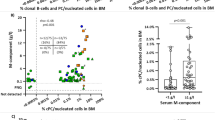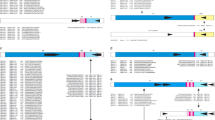Abstract
Contaminating tumour cells in apheresis products have proved to influence the outcome of patients with multiple myeloma (MM) undergoing autologous stem cell transplantation (APBSCT). The gene scanning of clonally rearranged VDJ segments of the heavy chain immunoglobulin gene (VDJH) is a reproducible and easy to perform technique that can be optimised for clinical laboratories. We used it to analyse the aphereses of 27 MM patients undergoing APBSCT with clonally detectable VDJH segments, and 14 of them yielded monoclonal peaks in at least one apheresis product. The presence of positive results was not related to any pre-transplant characteristics, except the age at diagnosis (lower in patients with negative products, P = 0.04). Moreover, a better pre-transplant response trended to associate with a negative result (P = 0.069). Patients with clonally free products were more likely to obtain a better response to transplant (complete remission, 54% vs 28%; >90% reduction in the M-component, 93% vs 43% P = 0.028). In addition, patients transplanted with polyclonal products had longer progression-free survival, (39 vs 19 months, P = 0.037) and overall survival (81% vs 28% at 5 years, P = 0.045) than those transplanted with monoclonal apheresis. In summary, the gene scanning of apheresis products is a useful and clinically relevant technique in MM transplanted patients. Bone Marrow Transplantation (2001) 28, 665–672.
This is a preview of subscription content, access via your institution
Access options
Subscribe to this journal
Receive 12 print issues and online access
$259.00 per year
only $21.58 per issue
Buy this article
- Purchase on Springer Link
- Instant access to full article PDF
Prices may be subject to local taxes which are calculated during checkout




Similar content being viewed by others
References
San Miguel JF, Bladé CJ, García-Sanz R . Treatment of multiple myeloma Haematologica 1999 84: 36–58
Attal M, Harousseau JL, Stoppa AM et al. A prospective, randomized trial of autologous bone marrow transplantation and chemotherapy in multiple myeloma. Intergroupe Francais du Myelome New Engl J Med 1996 335: 91–97
Boccadoro M, Pileri A . Diagnosis, prognosis, and standard treatment of multiple myeloma Hematol Oncol Clin North Am 1997 11: 111–131
Tricot G, Jagannath S, Vesole D et al. Peripheral blood stem cell transplants for multiple myeloma: identification of favorable variables for rapid engraftment in 225 patients Blood 1995 85: 588–596
Haas R, Mohle R, Fruhauf S et al. Patient characteristics associated with successful mobilizing and autografting of peripheral blood progenitor cells in malignant lymphoma Blood 1994 83: 3787–3794
Goldschmidt H, Hegenbart U, Wallmeier M et al. Factors influencing collection of peripheral blood progenitor cells following high-dose cyclophosphamide and granulocyte colony-stimulating factor in patients with multiple myeloma Br J Haematol 1997 98: 736–744
Mahe B, Milpied N, Hermouet S et al. G-CSF alone mobilizes sufficient peripheral blood CD34+ cells for positive selection in newly diagnosed patients with myeloma Br J Haematol 1996 92: 263–268
Bellos F, Cremer FW, Ehrbrecht E et al. Leukapheresis cells of patients with multiple myeloma collected after mobilization with chemotherapy and G-CSF do not bear Kaposi's sarcoma associated herpesvirus DNA Br J Haematol 1998 103: 1192–1197
López-Pérez R, García-Sanz R, González M et al. The detection of contaminating clonal cells in apheresis products is related to response and outcome in multiple myeloma undergoing autologous peripheral blood stem cell transplantation Leukemia 2000 14: 1493–1499
Brenner MK, Rill DR, Holladay MS et al. Gene marking to determine whether autologous marrow infusion restores long-term haemopoiesis in cancer patients Lancet 1993 342: 1134–1137
Gertz MA, Witzig TE, Pineda AA et al. Monoclonal plasma cells in the blood stem cell harvest from patients with multiple myeloma are associated with shortened relapse-free survival after transplantation Bone Marrow Transplant 1997 19: 337–342
Dreyfus F, Ribrag V, Leblond V et al. Detection of malignant B cells in peripheral blood stem cell collections after chemotherapy in patients with multiple myeloma Bone Marrow Transplant 1995 15: 707–711
Witzig TE, Gertz MA, Pineda AA et al. Detection of monoclonal plasma cells in the peripheral blood stem cell harvests of patients with multiple myeloma Br J Haematol 1995 89: 640–642
Witzig TE, Kyle RA, O'Fallon WM, Greipp PR . Detection of peripheral blood plasma cells as a predictor of disease course in patients with smouldering multiple myeloma Br J Haematol 1994 87: 266–272
Mitterer M, Oduncu F, Lanthaler AJ et al. The relationship between monoclonal myeloma precursor B cells in the peripheral blood stem cell harvests and the clinical response of multiple myeloma patients Br J Haematol 1999 106: 737–743
Schiller G, Vescio R, Freytes C et al. Transplantation of CD34+ peripheral blood progenitor cells after high-dose chemotherapy for patients with advanced multiple myeloma Blood 1995 86: 390–397
Vescio R, Schiller G, Stewart AK et al. Multicenter phase III trial to evaluate CD34(+) selected versus unselected autologous peripheral blood progenitor cell transplantation in multiple myeloma Blood 1999 93: 1858–1868
Vescio RA, Han EJ, Schiller GJ et al. Quantitative comparison of multiple myeloma tumor contamination in bone marrow harvest and leukapheresis autografts Bone Marrow Transplant 1996 18: 103–110
Corradini P, Voena C, Astolfi M et al. High-dose sequential chemoradiotherapy in multiple myeloma: residual tumor cells are detectable in bone marrow and peripheral blood cell harvests and after autografting Blood 1995 85: 1596–1602
Lemoli RM, Fortuna A, Motta MR et al. Concomitant mobilization of plasma cells and hematopoietic progenitors into peripheral blood of multiple myeloma patients: positive selection and transplantation of enriched CD34+ cells to remove circulating tumor cells Blood 1996 87: 1625–1634
Cremer FW, Kiel K, Wallmeier M et al. Leukapheresis products in multiple myeloma: lower tumor load after mobilization with cyclophosphamide plus granulocyte colony-stimulating factor (G-CSF) compared with G-CSF alone Exp Hematol 1998 26: 969–975
Bird JM, Russell NH, Samson D . Minimal residual disease after bone marrow transplantation for multiple myeloma: evidence for cure in long-term survivors Bone Marrow Transplant 1993 12: 651–654
Mariette X, Fermand JP, Brouet JC . Myeloma cell contamination of peripheral blood stem cell grafts in patients with multiple myeloma treated by high-dose therapy Bone Marrow Transplant 1994 14: 47–50
Langerak AW, Szczepanski T, van der Burg M et al. Heteroduplex PCR analysis of rearranged T cell receptor genes for clonality assessment in suspect T cell proliferations Leukemia 1997 11: 2192–2199
The Chronic Leukemia–Myeloma Task Force . Proposed guidelines for protocol studies. I. Introduction. II. Plasma cell myeloma. 3. Chronic lymphocytic leukemia. IV. Chronic granulocytic leukemia Cancer Chemother Rep 1973 4: 141–173
García-Sanz R, López-Pérez R, Langerak AW et al. Heteroduplex PCR analysis of rearranged immunoglobulin genes for clonality assessment in multiple myeloma Haematologica 1999 84: 328–335
Alegre A, Díaz-Mediavilla J, San-Miguel J et al. Autologous peripheral blood stem cell transplantation for multiple myeloma: a report of 259 cases from the Spanish Registry. Spanish Registry for Transplant in MM (Grupo Español de Trasplante Hematopoyetico-GETH) and PETHEMA. Comparison of peripheral blood progenitor cell mobilization in patients with multiple myeloma: high-dose cyclophosphamide plus GM-CSF vs G-CSF alone Bone Marrow Transplant 1998 21: 133–140
Pérez-Simón JA, Caballero MD, Corral M et al. Minimal number of circulating CD34+ cells to ensure successful leukapheresis and engraftment in autologous peripheral blood progenitor cell transplantation Transfusion 1998 38: 385–391
Lahuerta JJ, Martínez-Lopez J, Serna JD et al. Remission status defined by immunofixation vs electrophoresis after autologous transplantation has a major impact on the outcome of multiple myeloma patients Br J Haematol 2000 109: 438–446
Bladé J, Samson D, Reece D et al. Criteria for evaluating disease response and progression in patients with multiple myeloma treated by high-dose therapy and haemopoietic stem cell transplantation. Myeloma Subcommittee of the EBMT. European Group for Blood and Marrow Transplant Br J Haematol 1998 102: 1115–1123
Almeida J, Orfao A, Ocqueteau M et al. High-sensitive immunophenotyping and DNA ploidy studies for the investigation of minimal residual disease in multiple myeloma Br J Haematol 1999 107: 121–131
González M, González D, López-Pérez R et al. Heteroduplex analysis of VDJ amplified segments from rearranged IgH genes for clonality assessments in B-cell non-Hodkin's lymphoma. A comparision between different strategies Haematologica 1999 84: 779–784
Corradini P, Voena C, Tarella C et al. Molecular and clinical remissions in multiple myeloma: role of autologous and allogeneic transplantation of hematopoietic cells J Clin Oncol 1999 17: 208–215
Martinelli G, Terragna C, Lemoli R et al. Clinical and molecular follow-up by amplification of the CDR-III IgH region in multiple myeloma patients after autologous transplantation of hematopoietic CD34+ stem cells Haematologica 1999 84: 397–404
Lemoli RM, Cavo M, Fortuna A . Concomitant mobilization of plasma cells and hematopoietic progenitors into peripheral blood of patients with multiple myeloma J Hematother 1996 5: 339–349
Björkstrand B, Ljungman P, Bird JM et al. Double high-dose chemoradiotherapy with autologous stem cell transplantation can induce molecular remissions in multiple myeloma Bone Marrow Transplant 1995 15: 367–371
Dreyfus F, Melle J, Quarre MC, Pillier C . Contamination of peripheral blood by monoclonal B cells following treatment of multiple myeloma by high-dose chemotherapy Br J Haematol 1993 85: 411–412
Swedin A, Lenhoff S, Olofsson T et al. Clinical utility of immunoglobulin heavy chain gene rearrangement identification for tumour cell detection in multiple myeloma Br J Haematol 1998 103: 1145–1151
Bird JM, Bloxham D, Samson D et al. Molecular detection of clonally rearranged cells in peripheral blood progenitor cell harvests from multiple myeloma patients Br J Haematol 1994 88: 110–116
Acknowledgements
The authors thank Mark Anderson and Felicitación García for their technical assistance. This work has been partially supported with the grant number 99/1243 from the Spanish ‘Fondo de Investigaciones Sanitarias’ and the grant 1997 from the ‘Areces Foundation’.
Author information
Authors and Affiliations
Rights and permissions
About this article
Cite this article
López-Pérez, R., García-Sanz, R., González, D. et al. Gene scanning of VDJH-amplified segments is a clinically relevant technique to detect contaminating tumor cells in the apheresis products of multiple myeloma patients undergoing autologous peripheral blood stem cell transplantation. Bone Marrow Transplant 28, 665–672 (2001). https://doi.org/10.1038/sj.bmt.1703219
Received:
Accepted:
Published:
Issue Date:
DOI: https://doi.org/10.1038/sj.bmt.1703219
Keywords
This article is cited by
-
Reprogramming human B cells into induced pluripotent stem cells and its enhancement by C/EBPα
Leukemia (2016)
-
Critical evaluation of ASO RQ-PCR for minimal residual disease evaluation in multiple myeloma. A comparative analysis with flow cytometry
Leukemia (2014)
-
Capillary electrophoresis single-strand conformation analysis (CE-SSCA) for clonality detection in lymphoproliferative disorders
Journal of Hematopathology (2012)
-
Safety and efficacy assessment of plerixafor in patients with multiple myeloma proven or predicted to be poor mobilizers, including assessment of tumor cell mobilization
Bone Marrow Transplantation (2010)



